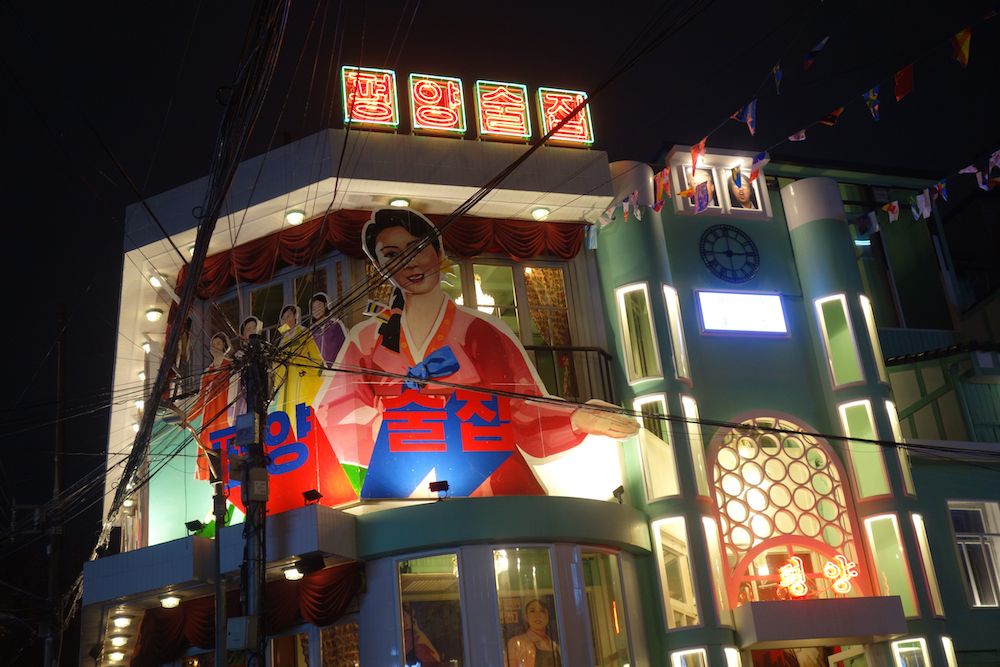North Koreans aren’t especially hard to come by in Seoul. Here and there around the city I’ve had the chance to attend a few talks given by defectors from the other side of the border, the most recent of which happened as part of the Seoul Biennale of Architecture and Urbanism. That day’s North Korean was a 35-year-old guy whom the host asked to discuss aspects of daily life in Pyongyang, like dating culture and how girls there wear their makeup differently than they do in Seoul — at least to the extent that he could remember them. A small North-South cultural exchange club had done its part to bring him onstage, and as part of their regular series of events they also held a North Korean cooking class last weekend. There I learned to make ogeurangjuk (오그랑죽), a kind of porridge with rice, adzuki beans, and gnocchi-like dumplings made of potato, potatoes being an agricultural specialty of the North as well as the northernmost province of the South.
Our teacher was a genuine North Korean, a woman who’d arrived in South Korea just one year before I did. I wondered whether I would struggle to understand her Northern accent and vocabulary, but I needn’t have; not only did she speak more or less like a Southerner, she’d also acquired a Southerner’s command of English — or rather, Konglish — loanwords. (She also introduced herself with an English name, “Jessie,” which she uses on her North Korean cooking Youtube channel.) One of the shockinghan things she found upon arriving in the South, she told us, was how sweet Southerners eat their own porridges. Ogeurangjuk, by comparison, has what one might call an understated flavor, hence the bowls of salt provided at each cooking station. But the salt wasn’t enough for another of the Northerners present, a voluble young guy who helped out with the cooking and cracked jokes at every opportunity. He dug through all the cooking supplies in the kitchen until he came upon a bag of sugar, his exaltation at the discovery of which suggested a ready assimilation to Southern tastes.
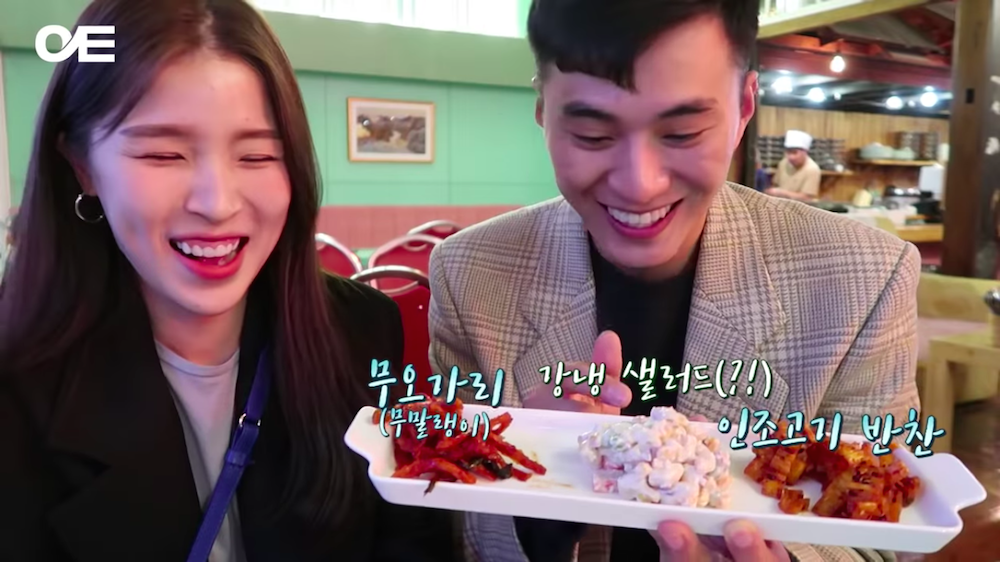
But like a surprising number of others in his generation of South Korea-resident North Koreans, he didn’t take great pains to conceal his national origin. He even popped up in a recent Youtube video, produced for a channel created by national news agency Yonhap’s Unification Media Institute, about the Pyongyang Pub (평양술집), a newly opened eating and drinking establishment meant to give Seoulites a taste of the Northern capital. But by all appearances it does so less to encourage unification, or even to promote cultural exchange, than to capitalize on a potential trend, a practice not unknown in the South Korean marketplace. It has also benefited from stirring up controversy: it made the news back in September, before it even opened, when it was ordered to take down the portraits of former North Korean leaders Kim Il-sung and Kim Jong-il hung on the building’s exterior in the same manner — North Korea travelogues never fail to mention it — as they hang, by law, in each and every North Korean home.
The Pyongyang Pub’s portraits risked running afoul of the 1948 National Security Act, and specifically its Article 7, which bans “praising, inciting or promoting the activities” of enemies of the Republic of Korea in general and friends of the Democratic People’s Republic of Korea in particular. Even in recent years South Korean citizens have gone to jail for violating it, and in ways as innocuous as retweeting a single North Korean propaganda tweet (despite the settled law of Twitter culture that “retweet ≠ endorsement”). The National Security Act was more rigorously enforced under the conservative administration of Park Geun-hye, which ended with her impeachment in 2017, than it is now, but even as indictment figures have fallen, referring to the North in a high-profile and non-condemnatory manner still feels like faintly risky business. But at this particular moment, opening a restaurant covered in slogans like “More alcohol to the comrades!”, “Revelry is the highest and greatest happiness!” and “Let’s consciously cultivate drinking manners!” — all rendered in an imitation of Northern revolutionese — may also turn out to be a profitable business.
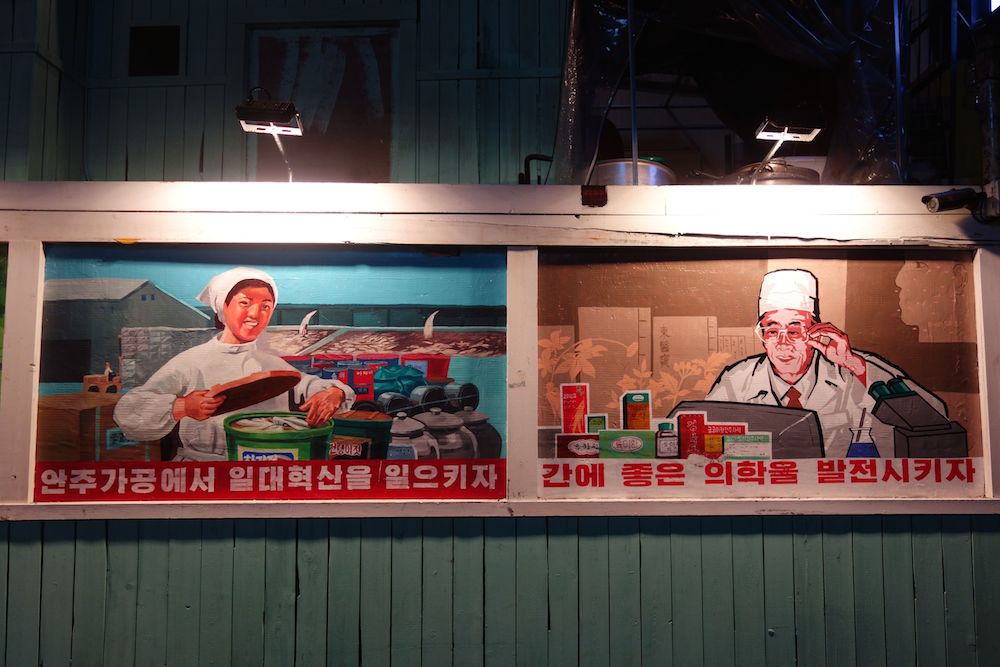
The thrill of transgression surely plays a part. Earlier this year I worked on a translation of a stage play about workers at the Kaesong Industrial Complex, the special administrative region of North Korea in which South Korean companies operated Northerner-employing factories from 2002 until its closure in a fit of Park-administration pique in 2016. One scene involves playing the North Korean national anthem, start to finish, while three South Korean characters stand at attention. “Part of me feels like, Should I report this?” said the professor overseeing the translation, a 50-year-old South Korean who remembers walking to class in college through the haze of protest-dispersing tear gas. Even the generation-younger Southern characters in the play recall school textbooks depicting Northerners with devil horns growing out of their foreheads. (The representative bout of North Korea panic in my mind occurs in Hong Sangsoo‘s Night and Day. Exiled to Paris by his country’s stringent drug laws, the fortysomething Southern protagonist happens to meet a Northern student at a party, immediately freaks out, and demands to know what he thinks of Kim Il-sung.)
But times have changed: not only has South Korean president Moon Jae-in spoken of his desire to reopen and expand the Kaesong Industrial Complex, he’s also famously met one-on-one with his Northern counterpart. The ascendance of Moon’s generation of the South Korean left, whose own college years coincided with a vogue for declaring one’s sympathy with the North, has also done something to change the tone of Southern public life. In all but the oldest South Koreans, pure fear and loathing (mixed, in an ever-shrinking number of cases, with memories of family members on the other side of the border unseen since the war) has given way to curiosity, and in the young an amused curiosity. For them, sweetcorn pancakes and blood sausage washed down with a few bottles of ersatz North Korean beer makes for a promising start to a Friday night — especially if happens in a highly Instagrammable environment unlike any of Seoul’s countless other highly Instagrammable environments. (For the ladies who want to look the part, the Pyongyang Pub also rents out traditional hanbok dresses in the Northern style.)
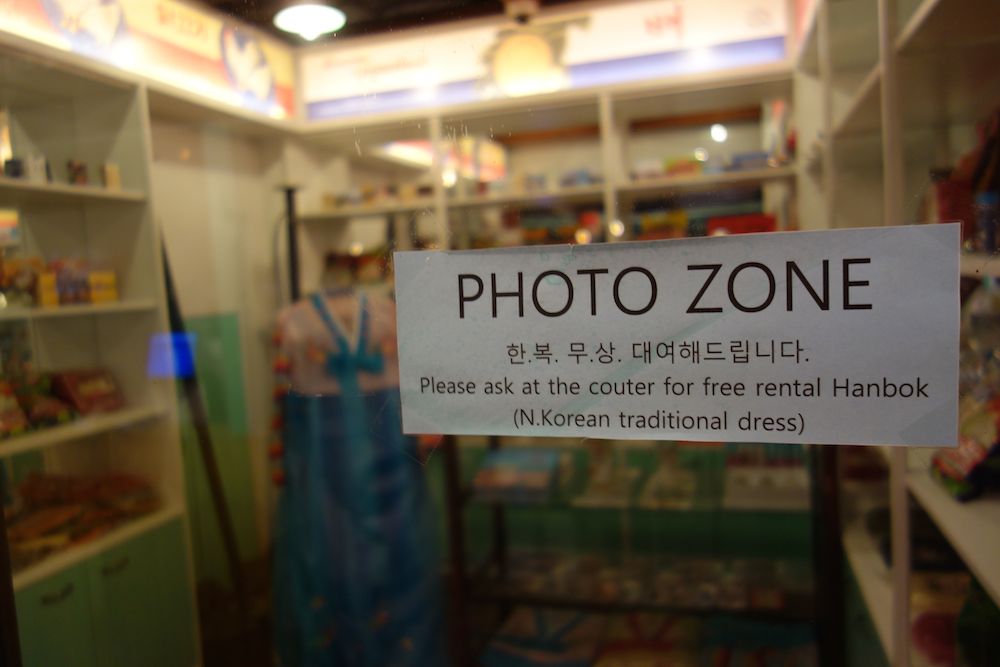
To the young North Koreans in the aforelinked Unification Media Institute video, the decorators of the Pyongyang Pub have indeed captured something of the homeland. (And even they see the humor in the lettering above the restrooms stating that indoor smokers are subject to punishment by firing squad.) Near the entrance is a “photo zone” filled with real North Korean consumer products, from cigarettes to ginseng candy. The walls, colored the same peach and mint seen on the buildings of Pyongyang itself, feature murals with a credible look of socialist realism. The chandeliers bring to mind photographs of the Pyongyang metro, and many of the tables are made from iron pedal-operated sewing machines. The soft-drink menu offers not “Coca-Cola” but, literally, “cocoa carbonated water.” The soundtrack mixes vintage pop music from North and South with the occasional incongruous, or seemingly incongruous, Western hit. On my visit Rick Astley’s “Together Forever” came out of nowhere, but it did bring to mind the mid-1980s Seoul of Chilsu and Mansu, featuring as that movie’s disco scene did Astley’s “Never Gonna Give You Up.”
A phenomenon like the Pyongyang Pub, scarcely imaginable a decade ago, might be less convincingly explained by explicitly of positive feelings about the North than by the recent embrace of all things retro — now labeled in trend-pieces with the mashed-up loanword “newtro.” Not so long ago, upwardly mobile Southerners took pains as great to distance themselves from their own recent past as they did to distance themselves from the North. The thing to escape was association with poverty, whether that of a still-developing nation or that of the dysfunctional neighbor across the 38th parallel. Hence the frantic association with all things Western satirized in films like Chilsu and Mansu: the spectacle of Korean twentysomtethings wearing jeans, eating at Burger King, and gyrating to Stock Aitken Waterman singles may express real aspirations, but it’s also powerful kitsch. Today that kind of striving looks rather more shameful than poverty, but productions like the 2015 television drama Reply 1988 (응답하라 1988) reflect a new tendency to look back on that period with fondness.
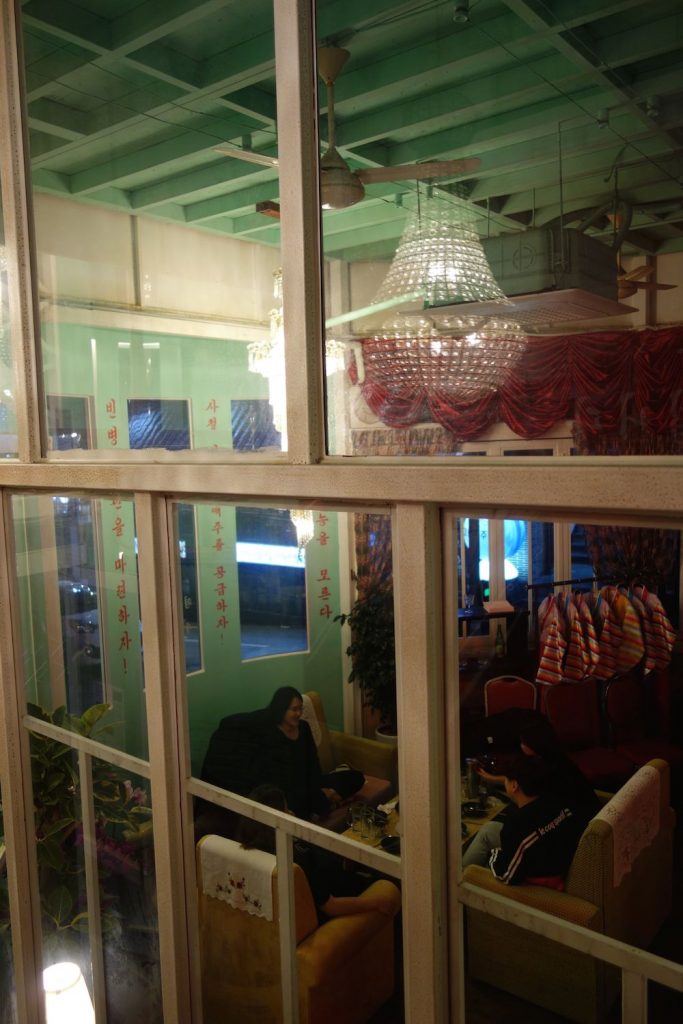
“Time may enhance what seems simply dogged or lacking in fantasy now because we are too close to it, because it resembles too closely our own everyday fantasies, the fantastic nature of which we don’t perceive,” writes Susan Sontag in “Notes on ‘Camp’,” the 1964 essay in which she defines what she calls Camp taste. “We are better able to enjoy a fantasy as a fantasy when it is not our own.” As with the crass aspirations of the developing South, so with the utopian delusions of the “hermit kingdom” of the North. To current South Korean twentysomethings, who whatever their personal circumstances have no experience of life in a desperately poor country, both have become sources of stylistic inspiration. Busily tending their social-media accounts, they naturally see the world, in Sontag’s words, “as an aesthetic phenomenon.” To emphasize style in this way “is to slight content, or to introduce an attitude which is neutral with respect to content. It goes without saying that the Camp sensibility is disengaged, depoliticized — or at least apolitical.”
The Pyongyang Pub opened in the neighborhood any Seoulite would expect it to: Hongdae, which spreads out below the country’s biggest art school, Hongik University. Such an institution encourages an awareness, on an intellectual or at least an instinctive level, of Camp, which as Sontag writes “has an affinity for certain arts rather than others,” especially “clothes, furniture, all the elements of visual decor.” All those elements are strongly emphasized at the Pyongyang Pub, the place in the city where one can most clearly witness how “time liberates the work from any moral relevance, delivering it over to the Camp sensibility.” On one level, it’s just a more newsworthy manifestation of the trend that has lately given rise to newtro eateries like the 1988 Olympic Village (also located in Hongdae), a frozen-pork-belly joint that revives the time of modern South Korea’s debut on the world stage, or any number of non-themed restaurants decorated with household appliances made romantic by their obsolescence. But it also feels like a space that could only exist here at the End of History.
“The relation of boredom and Camp taste cannot be overestimated,” Sontag writes. “Camp taste is by its nature possible only in affluent societies, in societies or circles capable of experiencing the psychopathology of affluence.” A right-wing critique of this psychopathology as it afflicts the affluent society of South Korea would have to take the Pyongyang Pub as an sign of pervasive weakness against the moral and indeed existential threat posed by the communists next door. A left-wing critique would surely take exception to the appropriation of the ongoing humanitarian disaster that is North Korea as a backdrop for an adult playground. But neither of those charges will have any consequence, and the only real threat the Pyongyang Pub faces to its own existence is the loss of its novelty. Seoul has long had restaurants that specialize in North Korean dishes like cold noodles and stuffed squid, but never before have they played up the North Korean propaganda aesthetic. If they follow Pyongyang Pub’s lead, this could be the beginning of a major fad.
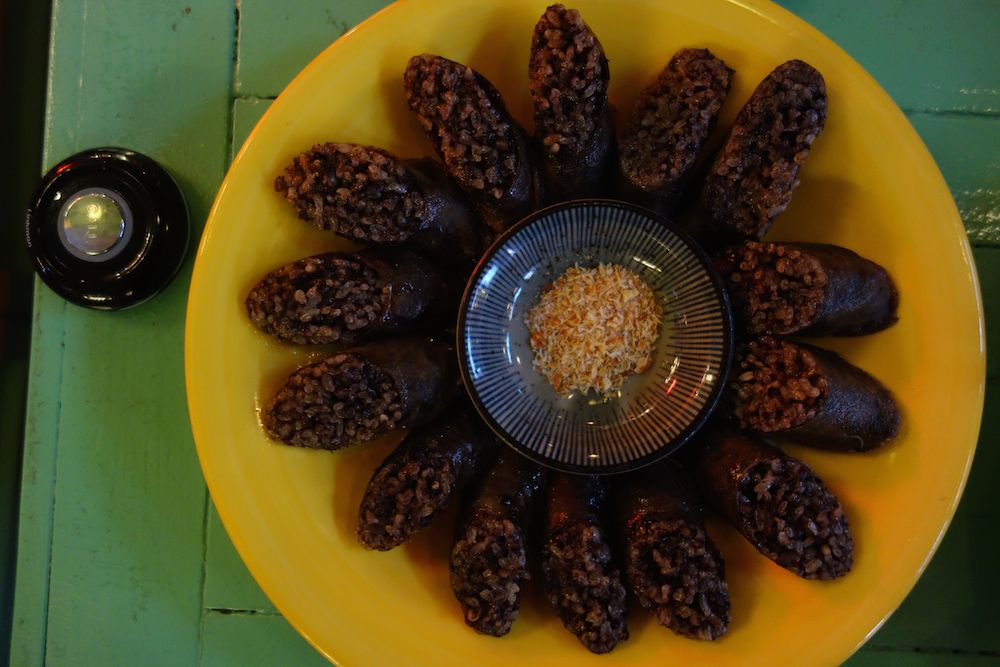
“Let’s combine the strength of the whole people and build a powerful drinking nation!” exhorted the sign above my table. “One dream, one wish! Soju! Beer!” Though modeled after North Korean brews, the Pyongyang Pub’s beer comes from Germany. As for soju, customers have their choice of the South Korean brands Chamisul, Jinro, and Chum Churum, the last of which is now running a Youtube ad emphasizing its made-in-the-ROK credentials. Beginning with the phrase “the reason I drink Chum Churum,” the video shows a factory worker inspecting a bottle — “because my husband makes it” — a lab-coated taste-tester — “because my father makes it” — a graphic designer working on a label — “because my wife makes it” — and a couple of young professionals delivering crates to a fish market — “because my son and daughter make it.” Even as a non-Korean I can sense the strength of the emotions stoked by evoking “our soju, made by the Korean people”: pride in that people, but also in one’s own participation in the work of building not just a brand but a nation.
North Korea’s public-facing propaganda, increasingly a curiosity in South Korea and long an object of ridicule in the rest of the world, uses these same basic emotions, albeit in an intensified and more aggressive form. Much remains to be done up North, as even the most sympathetic observer would admit, but down here in the South, where the nation has been more or less built, the work of nation-building itself has become the stuff of nostalgia, and nostalgia takes on an especially powerful form for those too young to have experienced its original referent. The Pyongyang Pub’s use of imagery and language has a mildly satirical aspect (“Dear Leader commands you to try three dishes and a beer!”), but it almost comes off as perfunctory; nobody there seems to be laughing at the North, exactly. And even the most cynical Westerner may be given pause by their own not-entirely-sneering reactions to the notion of a vast collective work, as well as by their not-entirely-pleasurable feelings about the fact that the work actually at hand comes to little more than eating, drinking, and Instagramming.
Related Korea Blog posts:
The Making of a Dictator: Anna Fifield’s Extensive Kim Jong Un Biography The Great Successor
The Colors of Pyongyang, Seoul’s Shadow Self
On Not Being Interested in North Korea
When Chris Marker Freely Photographed, and Briefly Fell in Love with, North Korea
A Python Goes to Pyongyang (and Well Beyond): Michael Palin in North Korea
Listen to the Seoul of the 1980s, Real or Imagined, with Streaming Mixes of Korean “City Pop”
Based in Seoul, Colin Marshall hosts the Korean-language podcast 콜린의 한국 (Colin’s Korea) and is at work on a book called The Stateless City: a Walk through 21st-Century Los Angeles. You can follow him at his web site, on Twitter @colinmarshall, or on Facebook.


